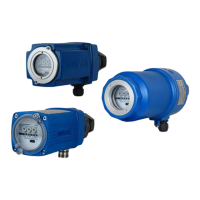3 | Explosion protection
D-LX 201/721
17
3 Explosion protection
This section affects only those flame monitors with housings M4 and S2 (suitable for
operation in zone 1/21 of potentially explosive areas) and the devices with housing M5
that offer explosion protection: Models D-LX*/86Ex/* (suitable for operating in Div. 2 of
hazardous areas) and D-LX*/87Ex/* (suitable for operating in zone 2/22 of hazardous
areas).
Information on the housing is provided as part of the model designation on the type la-
bel (see section 5.7 Name of the product [}36]). Explanations on the type code can
be found in section 5.8 Type code [}38]. Information on the explosion protection can
be found on the Ex type label (see section 3.8 Ex type label [}23]).
3.1 Basics
In many areas of industry, flammable gases, vapours, mists or dust are produced as a
result of production, processing, transport and storage. These combustible materials
can form explosive atmospheres with oxygen, for instance from the air. Should these
ignite, for example due to electrical sparks, serious personal injury and material dam-
age may result. The company which operates the devices is responsible for prevent-
ing any risk of explosion and guaranteeing the required level of safety.
The product therefore needs to be structurally designed in accordance with the latest
knowledge regarding explosion protection and manufactured to an appropriate level of
quality. In addition, professional installation and preventative maintenance of all relev-
ant components are required.
Devices for hazardous areas are relevant in terms of safety and are subject to a par-
ticular duty of care. Expert knowledge of explosion protection (corresponding to the
national regulations) is a prerequisite for any planning or work. This also applies to the
choice of suitable ignition protection categories and the classification of hazardous
areas into zones, as well as the correct assembly, commissioning, repair or exchange
of devices and accessories.
The basic principles for explosion protection are the same all over the world. In the
Member States of the European Union, explosion protection is governed by the ATEX
guidelines (French ATmosphère EXplosible). The guidelines are implemented through
harmonised European standards which to a large extent correspond to the IECEx
standards (International Electrotechnical Commission Explosive). Differences for in-
stance arise with respect to North American explosion protection.
3.2 Classification of the equipment groups into categories
Device group I covers explosion-proof devices used in areas with potentially explos-
ives in the mining industry.
Device group II covers all other explosion-proof devices.
The flame monitor is only suitable for hazardous areas in device group II.
Device group II is divided into categories 1, 2 and 3, with decreasing levels of safety.

